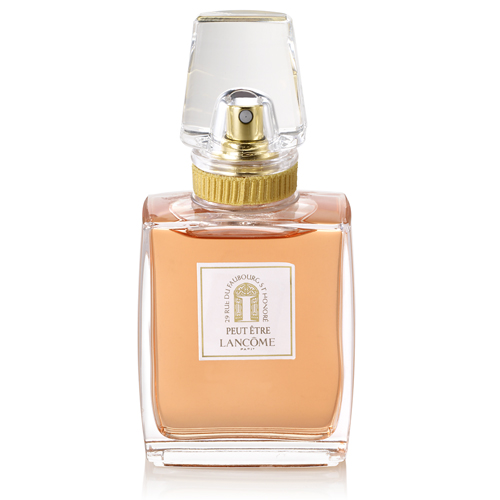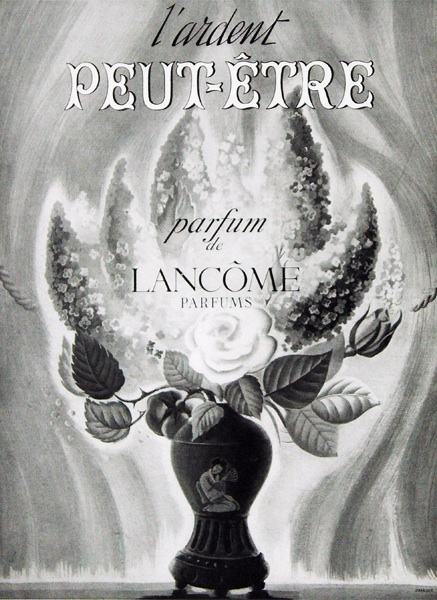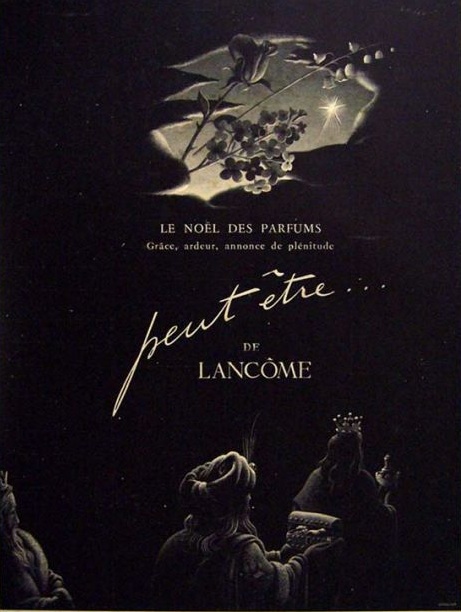Lancôme Peut-Être (1937-2008) {Perfume Review} {New Fragrance}

Lancôme Peut Etre (2008), which means "maybe" in French (normally written with a hyphen, "peut-être") is a feminine rose and iris composition brushed with fresh and green spring-like notes on top while offering at the same time a warm ambery-musky counterpoint in the base. The latter consists in a sumptuous, endless incense-y and resinous dry-down. The perfume offers thus two distinct atmospheres.Connoisseurs of old-school perfumes with lasting yet elegant sillages should be delighted. According to the Financial Times,
"La Collection brings together original masterpieces whose compositions reveal surprising complexities," says Liz Mearing of Lancôme. "These fragrances also capture a recent trend for beautiful, vintage scents that are created to the highest standards. It's very exciting to be able to offer something so special to a discerning, niche audience."
Lancôme initially launched Peut-Etre in 1937 and it is ascribed to Armand Petitjean who was not a perfumer but the founder of the brand. He is also known as a former managing-director and apprentice of François Coty, the father of modern commercial perfumery.
This spring Lancôme reintroduced a reorchestration of the original scent in La Collection series of "haute parfumerie classics". The original perfume was reportedly updated and recreated by perfumer Nathalie Lorson. It is classified by the brand as a musky floral, which is a bit of an over- simplification for a scent that presents other meaningful facets.
I experienced an authentic shock of discovery after having described the perfume and written about some of the images it suggested to me as then I happened on a 1940 advert for Peut-Etre by E.M. Pérot where the iconography seemed to mirror my description of the new scent (see after the jump).
This seems to indicate that Nathalie Lorson worked closely with the original formula as the imagery found in the 1940 advert is not hinted at in any way by the new press release (no incense is mentioned, for example).
It suddenly felt like a slightly disturbing oniric and pythian incursion into the realm of archetypes. If you look at the first advert below (also seen after testing the scent in fact), you can see a reiteration of the fundamental theme I describe in the review and which comes through much more clearly and precisely in the second 1940 advert.
These advertising images therefore do seem to speak about the perfume and about its main thrust as well as important secondary facets. Due to this "revelation" my review is layered, one more unaware and the other more informed, post-epiphany.....

According to the 2008 press release, the original Peut-Etre was inspired by a summer garden and the smell of "the last of the lilacs and the first of the roses....". It moreover included a lime-tree note. The ad copy invites you to imagine a woman alone in a French garden walking among roses, lilac, iris, and jasmine who is on the verge of encountering and living love, perhaps.
The new Peut-Etre is more than anything else an enhancer of femininity. There is something in its development that suggests a movement of sensual awakening taking place, perhaps, in a distant, adventurous land where feelings and senses are shaken out of their habits. Fresh, pristine notes emerging from a classical European garden are contrasted with deeper, more markedly exotic ones - musk and incense - suggesting, somehow, the archetype of the pure heroine dressed in white getting closer to a heart of darkness. It could have been worn by Ingrid Bergman in Casablanca. Peut-Etre can be felt as the luminous entrance of Bergman in Rick's Café, the glaring purity of her white dress standing against the sensuous black-and-white shadows, her limpid femininity against Rick's rough masculinity, her image of innocence set against the shady dealings of Nazis and Vichy officials in the dark continent of Africa. With this apposition, the scent also reveals itself to be much more Orientalist in spirit than initially expected. Furthermore, with its gently powdery, soapy and aldehydic accents and elegant signature, it feels at one point like a more typified Chanel No. 5. The advert (first one) for the original perfume seems to point to this top-to-bottom contrast that is the noticeable mark of the perfume: we see on the publicity a lush bouquet of lilacs and roses unfolding like a fan in an Oriental japonisant vase. The incensey and resinous iris in Peut-Etre seems to be burning by a nomadic camp fire under a starry night in the desert and the musk, to anoint the tents and carpets of Bedouins.

Discovery of The Advert by E.M Pérot
The image drawn by Pérot clarifies these impressions. A clear, ethereal, and luminous springy bouquet of European spring flowers - rose, lilac, lily of the valley - is floating against the sky seen through, strangely, the aperture of a dark cave while the bottom of the image is nocturnal, takes place somewhere in the desert perhaps in Africa as the Magi are bringing their offerings of incense, making their way under a starry night. Somehow, we had felt these impressions without knowing the ad.
Both adverts point to Peut-Etre as being a sort of hybrid scent. It is not really the structure of an oriental because the two atmospheres feel distinct. A floral becomes a trail of incense with perhaps the iris being used as a transition material between the two climates as its natural powderiness is suffused with an incensey impression.
It is also to be noted that the iris in Peut-Etre is very much iris-like, on the woody side, and not violet-like too as it often happens. The Lancôme rose is at its most exquisite in the drydown.
A Few More Things About Peut-Etre
Another way to point to this dichotomy existing in the scent is to underline yet another contrast that exists between coolness and warmth.
There is also an underlying Platonician structuring to the perfume in the sense that one feels that the bright floral peachy and green top notes followed by the dirty animalic and incensey ones seem to be like the embodiment of feminine and masculine principles and of a couple of lovers, woman and man.
Finally the honeyed nuances of the floral bouquet irresistibly and realistically evoke the delicately sweet balmy smell of the air in the springtime in the morning while the base notes with their slightly mystical nocturnal incensey accents are like a prelude to winter, an invitation to continue to wear Peut-Etre, into the night and up to Christmas at least, that is all year round. The perfume waxes and wanes forever fading in and out of its two main dual states.
Top note: Seringa flower; heart notes: Bulgarian rose essence and iris; base notes: musk and amber.
A 1. 7 oz bottle of Eau de Parfum retails for $125. It is available at Saks, Neiman Marcus, Nordstrom, Lancôme Boutiques, and online.










It is splendid blog. I am studied.
Dear MH, you've read a lot more in Peut-Etre than I did in the admittedly short time I sniffed it on paper. It seemed to me to be a very lovely, slightly aldehydic, powdery floral with some incense, much in the style of Chanel N°22, and very much the heir of Quelques Fleurs by Houbigant (in its vintage form) minus the vanilla base. I got the feeling it was Lancôme "me too" answer to 22. Nevertheless, this reedition is a very pretty, very retro, very feminine and delicate little thing. After your review, I should really go out and smell it again to tease more out of it!
Houbigant Quelques Fleurs and Chanel No. 22 are indeed in the same lineage, since they are respectively an inspiration for and a variation of Chanel No. 5. I have some vintage Quelques Fleurs, but I am not sure how vintage it is except that it is different from the modern version.
It made me think more of the fundamental character of Chanel No. 5 on an intuitive/unconscious level. The incense in Peut-Etre is much more resinous, exotic animalistically styled (frank musk), and down-to-earth than in Chanel No. 22. As I said, I was struck by an interest in a marked contrast in Peut-Etre while No. 22 is very smooth, elegant, rather restrained, much more aldehydic essentially and uses ambergris rather than vegetal amber. It is also heartbreakingly beautiful. Perhaps it is because No. 5 is more forceful and darker that it made me think more of it and it is after all the fundamental perfume of reference.
While smelling a scent on paper has its virtues such as liberating a note after a few days that was well-hidden in the composition, I do not think that one can base one's detailed impression of a perfume this way, especially for the purpose of perfume writing. To me it amounts to the difference between a 2-D and 3-D (skin) perception of a perfume. But both approaches are complementary.
What a fabulous and informative review! I can't wait to try this - I figured it would be one of the "exclusive" launches that never get to my city - but I live in Nordstrom country, hooray! We also have a Saks now. (This HAS to be better than the dreadful Lancome Benghal limited edition stuff I tried this winter -I wanted to chew my arm off after ten minutes with that one. )
Yuki,
Thank you for your kind words.
No doubt Peut Etre is much more upscale than Benghal and has had more attention and means devoted to it.
And thank you for your kind words.
Hi,
I bought this perfume the other day and absolutely love it.. i was in fact looking for a specific perfume which had more of a powdery smell [i don't know what the name of it was] -- the review is very interesting and informative.. Thanks :)
Thank you for your kind words. It is a lovely retro and feminine perfume.
Powdery perfumes would merit an article. Some people just adore perfumes that seem to end in a dusting of subtly-scented cosmetic rice powder.
Have you tried Lorenzo Villoresi Teint de Neige? This is powder perfection. Ombre Rose is another powdery classic. There are many more...I personally used to enjoy wearing Lutèce by Houbigant and Le 10 by Balenciaga (in pure extrait).